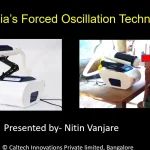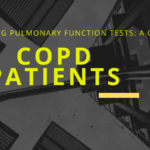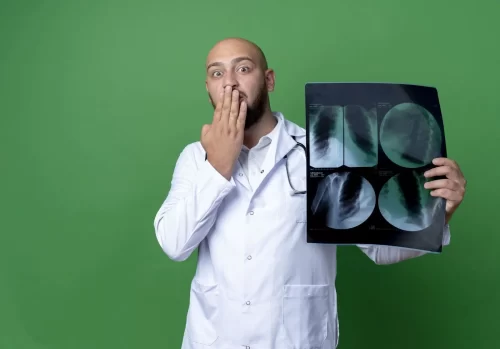
Basic Principle, Understanding The Resistance Versus Frequency And Reactance Versus Frequency Graphs.
January 4, 2024
Mastering Pulmonary Function Tests: A Guide for COPD Patients
July 27, 2024
With technological advancements, the future of pulmonary diagnosis devices offers immense promise for changing healthcare. Modern pulmonary diagnostic devices are designed to simplify the diagnostic procedure and make it easier, quicker, and more precise than in the past.
These modern machines use a variety of techniques, including imaging technologies, airway resistance measurements, and molecular diagnostics, to provide a complete picture of a patient's respiratory status.
Healthcare workers can more precisely diagnose respiratory disorders and evaluate lung function more quickly and efficiently by integrating several diagnostic tests into a single piece of equipment.
Furthermore, integrating artificial intelligence (AI) algorithms into lung diagnostic machines lowers the possibility of human error and improves result accuracy. Large-scale data analysis, database comparison, and prompt, precise diagnosis are all possible with AI algorithms, which enhance patient outcomes and cut down on needless medical procedures.
Pulmonary diagnostic devices will become a vital weapon in the fight against respiratory illnesses as time goes on. These devices have the power to revolutionize respiratory medicine and open the door to a healthier future by streamlining healthcare procedures, improving patient outcomes, and raising the accuracy of diagnostics.
Current challenges in pulmonary diagnosis
Many people with chronic obstructive pulmonary disease (COPD) or asthma have not received a diagnosis, so their respiratory symptoms remain largely untreated Source: New England Journal of Medicine.
A prompt and accurate pulmonary diagnosis is essential for respiratory disorders to be effectively treated and managed. However, some issues facing the healthcare system today make pulmonary diagnosis less effective. Conventional diagnostic techniques, which can be intrusive, time-consuming, and frequently necessitate repeated trips to medical institutions, are one of the main problems.
Traditional pulmonary diagnostics, such as chest X-rays and spirometry, offer little information and cannot always correctly pinpoint the underlying reason for a patient's respiratory problems. Furthermore, there is a chance that these test results will be interpreted subjectively, which could result in a delayed or incorrect diagnosis.
The rising incidence of respiratory illnesses, which is a major concern due to factors including smoking, air pollution, and aging populations, is another issue. The strain on available resources caused by the rise in demand for pulmonary healthcare services has resulted in worse patient outcomes, longer wait times and less access to specialized care.
These issues have been made worse by the COVID-19 epidemic, underscoring the pressing need for more effective and widely available pulmonary diagnostic tools.
The role of advanced pulmonary diagnostic machines
Some of the most common are chronic obstructive pulmonary disease (COPD), asthma, occupational lung diseases, and pulmonary hypertension. In addition to tobacco smoke, other risk factors include air pollution, occupational chemicals, dust, and frequent lower respiratory infections during childhood. Source: WHO
The development of sophisticated lung diagnostic equipment has shown promise for resolving the issues facing respiratory healthcare today.
With the use of these state-of-the-art tools, medical practitioners may diagnose patients more quickly and accurately, giving them a more thorough evaluation of their respiratory health.
These cutting-edge devices are built on novel technologies that make use of artificial intelligence (AI) algorithms, sensor-based measurements, and imaging capabilities.
These devices can conduct a variety of tests, from lung function evaluations to the early diagnosis of respiratory disorders, all in a single, effective session, thanks to the integration of various diagnostic modalities into a single device.
Benefits of streamlining healthcare with advanced pulmonary diagnostic machines
Both patients and healthcare practitioners can greatly benefit from the use of sophisticated pulmonary diagnostic devices in healthcare settings. Simplifying the diagnostic procedure can result in faster and more accurate diagnoses, which is one of the main benefits.
Patients can receive a full evaluation in a single visit by merging various tests into a single, thorough assessment. This eliminates the need for repeated appointments as well as the related costs and inconvenience.
This streamlined approach not only increases patient happiness but also frees up healthcare resources, allowing for more efficient use of clinicians' time and hospital facilities.
Additionally, the increased precision of these sophisticated devices may result in the early identification of respiratory disorders, permitting prompt therapies and better patient outcomes.
Types of Advanced Pulmonary Diagnostic Machines
Maintaining your lungs is essential to a long and healthy life. Fortunately, a range of cutting-edge instruments are available in modern medicine to diagnose lung issues. Let's check out some Pulmonary Diagnostic Machines:
Computed Tomography (CT) Scan

A CT scan uses X-rays to create detailed cross-sectional images of the body. In pulmonary diagnosis, CT scans can reveal abnormalities such as lung nodules, masses, inflammation, and infections.
Magnetic Resonance Imaging (MRI)
An MRI scan creates finely detailed images of bones, soft tissues, and organs by using radio waves and strong magnetic fields. MRIs can be used in pulmonary diagnostics to evaluate lung blood flow, find anomalies in the chest wall, and identify specific lung disorders.
Test of Lung Function Fitness
Spirometry

spirometry test for old people
This test measures how much air you can breathe in and out, and how quickly you can exhale. To help diagnose illnesses like asthma and COPD, you will blow into a machine that measures the amount of air you can breathe in and out.
Body Plethysmography
This test calculates the volume of your entire lung and helps determine conditions that impact the size or elasticity of your lungs.
Antlia Pro: An Exhalation of Fresh Air in Testing

Searching for an easy-to-use lung function test? ICalTech's Antlia Pro could be the solution. The Forced Oscillation Technique (FOT) is a cutting-edge apparatus that assesses your respiratory system as you breathe normally.
What sets Antlia Pro apart is as follows:
Antlia Pro has received tremendous recognition for its novel approach to pulmonary function testing. AGNii - Invest India held the Smart Cities Technology Showcase, where Antlia was shown as a novel medical gadget and was commended by the New Delhi Municipal Council (NMDC).
Computer Functioning and Non-Disruptive: It's a quick, easy test with no needles or discomfort.
Assesses Variable Conditions: evaluates problems with the central and peripheral airways.
Perfect for Every Patient: Ideal for individuals of all ages and capacities, including the young, frail, and old.
Easy & Low Work There is no requirement for forced breathing techniques because the test demands very little cooperation.
Patented Design: Antlia has two patents for its cutting-edge technology.
With Antlia Pro, lung function testing can be a breeze. Talk to your doctor to see if this advanced tool suits you.
Key features and capabilities of advanced pulmonary diagnostic machines
Advanced pulmonary diagnostic machines are built with various characteristics and capabilities that distinguish them from traditional diagnostic procedures.
The ability to combine various diagnostic modalities into one device is one of its primary benefits, which enables a thorough evaluation of a patient's respiratory health in a single session.
These devices frequently use cutting-edge imaging techniques to produce precise images of the lungs and airways, such as digital X-rays and high-resolution CT scans. This makes it possible for medical personnel to more precisely identify structural anomalies, identify respiratory disorders in their early stages, and track the progression of diseases.
Another crucial element is the inclusion of sensor-based data, such as diffusion capacity, lung volume, and airway resistance, which provide crucial information about respiratory mechanics and lung function.
Future advancements in pulmonary diagnosis
Pulmonary diagnosis has much more promise for the future as long as technology keeps improving. The incorporation of machine learning (ML) and artificial intelligence (AI) algorithms into sophisticated lung diagnostic devices is one area of continuous research.
Large volumes of patient data, such as imaging scans, lung function tests, and clinical records, can be analyzed by these AI-powered systems to find trends and produce more precise and individualized diagnoses.

Old way of diagnosis
These algorithms can continuously enhance their diagnostic abilities, resulting in more effective and dependable respiratory healthcare, by learning from new data and clinical outcomes.
The incorporation of remote monitoring technologies into the pulmonary diagnostic ecosystem, such as wearables and home-based testing kits, is another innovative field.
Implications of advanced pulmonary diagnostic machines for healthcare professionals
The use of modern pulmonary diagnostic devices has important consequences for healthcare workers, changing the way they approach respiratory treatment.
Improved diagnostic process accuracy and efficiency can result in improved patient outcomes and less labor for physicians, which is one of the main advantages.
These devices can save healthcare professionals' time by automating data processing and expediting the diagnostic workflow, enabling them to concentrate more on patient care and treatment planning.
As a result, physicians may experience a decrease in burnout and an increase in job satisfaction since they will have more time to interact with patients and make decisions based on thorough, trustworthy data.
Conclusion: The transformative potential of advanced pulmonary diagnostic machines
Advanced pulmonary diagnostic machines are at the vanguard of this transition, and the field of pulmonary diagnostics has a bright future ahead of it. These devices have the power to completely change the way respiratory healthcare is provided by improving accuracy, expediting the diagnosis procedure, and incorporating cutting-edge technologies.
Advanced pulmonary diagnostic equipment offers numerous advantages, including enhanced patient outcomes, lower healthcare costs, and a quicker and more precise diagnosis.
These technologies will be essential in tackling the rising number of respiratory illnesses and raising the standard of treatment as they develop and are embraced by a larger population. Modern pulmonary diagnostic equipment is a big step toward a time when respiratory care will be more effective, individualized, and available to everyone.




